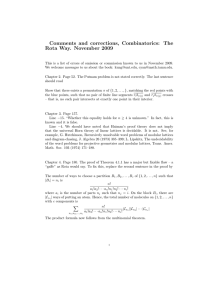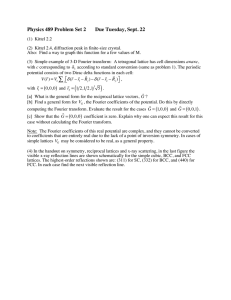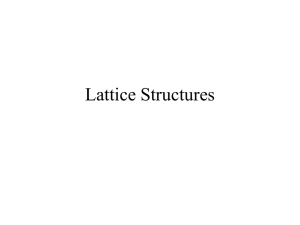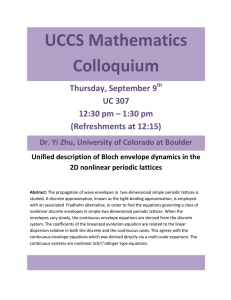Lattice Structures
advertisement
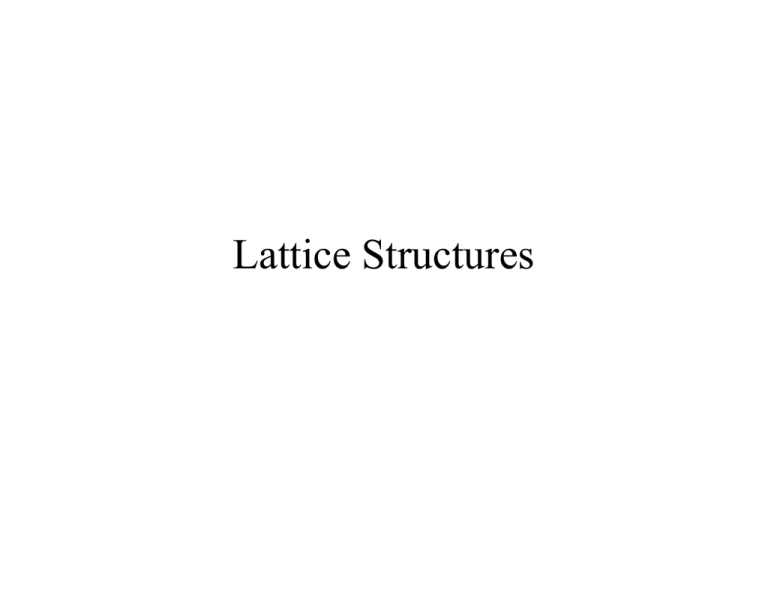
Lattice Structures Lattices Consider an mth-order FIR filter with Hm ( z ) = Y(z) X(z) m = ∑α m [k ] z −k k =0 where the α 's are the filter coefficients and α m [ 0] = 1 for any m. m Then h m [ n ] = ∑ α m [ k ]δ [ n − k ] and y [ n ] = x [ n ] ∗ α m [ n ] k =0 For m = 1, y [ n ] = α1 [ 0] x [ n ] + α1 [1] x [ n − 1]. Lattices The recursion relation y [ n ] = α1 [ 0] x [ n ] + α1 [1] x [ n − 1] can be realized by this lattice structure if K1 = α1 [1] and y [ n ]. = f1 [ n ]. Lattices The filter can also be described by ⎡ f1 [ n ] ⎤ ⎡ 1 ⎢ ⎥=⎢ ⎣g1 [ n ]⎦ ⎣ K1 or K1 ⎤ ⎡ f 0 [ n ] ⎤ ⎡ F1 ( z ) ⎤ ⎡ 1 ⎢ ⎥⇒⎢ ⎥=⎢ ⎥ 1 ⎦ ⎣g 0 [ n − 1]⎦ ⎣ G1 ( z ) ⎦ ⎣ K1 ⎡ y [ n] ⎤ ⎡ 1 ⎢ ⎥=⎢ ⎣g1 [ n ]⎦ ⎣ K1 K1 ⎤ ⎡ x [ n ] ⎤ ⎡ Y ( z ) ⎤ ⎡ 1 ⎢ ⎥⇒⎢ ⎥=⎢ ⎥ 1 ⎦ ⎣ x [ n − 1]⎦ ⎣ G1 ( z ) ⎦ ⎣ K1 K1 ⎤ ⎡ F0 ( z ) ⎤ ⎢ ⎥ 1 ⎥⎦ ⎣ z −1 G 0 ( z )⎦ K1 ⎤ ⎡ X ( z ) ⎤ ⎢ ⎥ 1 ⎥⎦ ⎣ z −1 X ( z ) ⎦ Multiplying out the matrices, Y ( z ) = X ( z ) + K1 z −1 X ( z ) ⇒ y [ n ] = x [ n ] + K1 x [ n − 1] G1 ( z ) = K1 X ( z ) + z −1 X ( z ) ⇒ g1 [ n ] = K1 x [ n ] + x [ n − 1] Notice that in these two recursion relations the coefficients occur in reverse order. Lattices Next consider a second-order FIR filter y [ n ] = α 2 [ 0] x [ n ] + α 2 [1] x [ n − 1] + α 2 [ 2] x [ n − 2]. N =1 Lattices ⎡ F1 ( z ) ⎤ ⎡ 1 ⎢ ⎥=⎢ ⎣G1 ( z ) ⎦ ⎣ K1 K1 ⎤ ⎡ F0 ( z ) ⎤ ⎢ ⎥ 1 ⎥⎦ ⎣ z −1 G 0 ( z ) ⎦ ⎡1 0 ⎤ ⎡ F1 ( z ) ⎤ ⎡ F1 ( z ) ⎤ ⎡1 0 ⎤ ⎡ 1 ⎢0 z −1 ⎥ ⎢G z ⎥ = ⎢ z −1 G z ⎥ = ⎢ 0 z −1 ⎥ ⎢ K ⎣ ⎦ ⎣ 1 ( )⎦ ⎣ ⎣ ⎦⎣ 1 1 ( )⎦ ⎡ F1 ( z ) ⎤ ⎡1 0 ⎤ ⎡ 1 ⎢ −1 ⎥=⎢ −1 ⎥ ⎢ G z z 0 z ( ) ⎦ ⎣ K1 1 ⎣ ⎦ ⎣ K1 ⎤ ⎡ X ( z ) ⎤ ⎢ ⎥ 1 ⎥⎦ ⎣ z −1 X ( z ) ⎦ K1 ⎤ ⎡ F0 ( z ) ⎤ ⎢ ⎥ 1 ⎥⎦ ⎣ z −1 G 0 ( z ) ⎦ Lattices ⎡ Y ( z ) ⎤ ⎡ F2 ( z ) ⎤ ⎡ 1 ⎢ ⎥=⎢ ⎥=⎢ ⎣G 2 ( z )⎦ ⎣G 2 ( z )⎦ ⎣ K 2 ⎡1 =⎢ ⎣ K2 K 2 ⎤ ⎡1 0 ⎤ ⎡ 1 1 ⎥⎦ ⎢⎣0 z −1 ⎥⎦ ⎢⎣ K1 K 2 ⎤ ⎡ F1 ( z ) ⎤ ⎢ −1 ⎥ ⎥ 1 ⎦ ⎣ z G1 ( z ) ⎦ K1 ⎤ ⎡ X ( z ) ⎤ ⎢ ⎥ 1 ⎥⎦ ⎣ z −1 X ( z ) ⎦ Multiplying the matrices, ⎡ Y ( z ) ⎤ ⎡1 + z −1 K1 K 2 ⎢ ⎥=⎢ −1 G z + K z K1 ( ) 2 ⎣ ⎦ ⎣ 2 K1 + z −1 K 2 ⎤ ⎡ X ( z ) ⎤ ⎥ ⎥ ⎢ −1 K1 K 2 + z −1 ⎦ ⎣ z X ( z ) ⎦ In the time domain Lattices y [ n ] = x [ n ] + K1 ( K 2 + 1) x [ n − 1] + K 2 x [ n − 2] g 2 [ n ] = K 2 x [ n ] + K1 ( K 2 + 1) x [ n − 1] + x [ n − 2] Again the coefficients occur in reverse order in the two recursion relations. This occurs for any value of m. If K1 ( K 2 + 1) = α 2 [1] and K 2 = α 2 [ 2] the upper lattice signal is the desired response and K1 = α 2 [1] α 2 [ 2] + 1 and K 2 = α 2 [ 2]. Lattices In the general ( M − 1) th order case, f0 [ n] = g 0 [ n] = x [ n] f m [ n ] = f m−1 [ n ] + K m g m−1 [ n − 1] , m = 0,1, 2," , M − 1 g m [ n ] = K m f m−1 [ n ] + g m−1 [ n − 1] , m = 0,1, 2," , M − 1 y [ n ] = f M −1 [ n ] Lattices The output signal from the mth stage is f m [ n ] = x [ n ] ∗ α m [ n ]. Therefore Fm ( z ) = X ( z ) Α m ( z ) = F0 ( z ) Α m ( z ) m Z where α m [ n ] ←⎯ → Αm ( z ) = ∑α m [ k ] z − k . k =0 Lattices Given that the coefficients for g are always the reverse of the coefficients for f, the other output signal of the mth stage is m g m [ n] = ∑α m [ m − k ] x [ n − k ] k =0 Let β m [ k ] = α m [ m − k ]. Then m g m [ n] = ∑ β m [ k ] x [ n − k ] = β m [ n] ∗ x [ n] k =0 Z and G m ( z ) = X ( z ) Βm ( z ) where β m [ n ] ←⎯ →Βm ( z ) . Lattices m From the definition β m [ k ] = α m [ m − k ] ⇒ Β m ( z ) = ∑ α m [ m − k ] z − k . Let k =0 0 m q =m q =0 q = m − k . Then Β m ( z ) = ∑ α m [ q ] z q−m = z − m ∑ α m [ q ] z q . It was shown m above that Α m ( z ) = ∑ α m [ k ] z − k therefore Βm ( z ) = z − m Α m (1/ z ) which k =0 implies that the zeros of Β m ( z ) are the reciprocals of the zeros of Α m ( z ) . Lattices Now the transfer function of the mth stage can be expressed in terms of the transfer function of the ( m − 1) th stage as ⎡ Αm ( z )⎤ ⎡ 1 ⎢ ⎥=⎢ ⎣ Βm ( z ) ⎦ ⎣ K m K m ⎤ ⎡ Α m−1 ( z ) ⎤ ⎢ ⎥ 1 ⎥⎦ ⎣ Β m−1 ( z ) ⎦ Lattices The coefficients α of the Direct Form II filter and the reflection coefficients of the lattice structure are related and the α 's can be found from the K's recursively by using Α0 ( z ) = Β0 ( z ) = 1 Α m ( z ) = Α m−1 ( z ) + K m z −1Β m−1 ( z ) Β m ( z ) = z − m Α m (1/ z ) Lattices Example Let the reflection coefficients be K1 = 1/ 2 , K 2 = 1/ 5 and K 3 = 3/ 4. Find the Direct Form II filter coefficients α . Solution Α0 ( z ) = Β0 ( z ) = 1 Α1 ( z ) = Α0 ( z ) + K1 z −1Β0 ( z ) = 1 + z −1 K1 = 1 + 0.5 z −1 Β1 ( z ) = z −1Α1 (1/ z ) = z −1 (1 + 0.5 z ) = 0.5 + z −1 Example (cont.) Solution Lattices Α 2 ( z ) = Α1 ( z ) + K 2 z −1Β1 ( z ) = 1 + 0.5 z −1 + 0.2 z −1 ( 0.5 + z −1 ) = 1 + 0.6 z −1 + 0.2 z −2 Β 2 ( z ) = z −2 Α 2 (1/ z ) = z −2 (1 + 0.6 z + 0.2 z 2 ) = 0.2 + 0.6 z −1 + z −2 Α3 ( z ) = Α 2 ( z ) + K 3 z −1Β 2 ( z ) = 1 + 0.6 z −1 + 0.2 z −2 + 0.75 z −1 ( 0.2 + 0.6 z −1 + z −2 ) = 1 + 0.75 z −1 + 0.65 z −2 + 0.75 z −3 Lattices Example (cont.) Solution Β3 ( z ) = z −3 Α3 (1/ z ) = z −3 (1 + 0.75 z + 0.65 z 2 + 0.75 z 3 ) = 0.75 + 0.65 z −1 + 0.75 z −2 + z −3 So α 3 [ 0] = 1, α 3 [1] = 0.75, α 3 [ 2] = 0.65 and α 3 [3] = 0.75 Lattices We can also find the reflection coefficients from the Direct Form II coefficients using Α m ( z ) = Α m−1 ( z ) + K m z −1Β m−1 ( z ) and g m [ n ] = K m f m−1 [ n ] + g m−1 [ n − 1] , m = 0,1, 2,", M − 1 z transforming we get G m ( z ) = K m Fm−1 ( z ) + z −1G m−1 ( z ) Lattices Dividing through by X ( z ) we get Β m ( z ) = K m Α m−1 ( z ) + z −1Β m−1 ( z ) ⇒ z −1Β m−1 ( z ) = Β m ( z ) − K m Α m−1 ( z ) Combining this with Α m ( z ) = Α m−1 ( z ) + K m z −1Β m−1 ( z ) we get Α m ( z ) = Α m−1 ( z ) + K m ⎣⎡Β m ( z ) − K m Α m−1 ( z ) ⎤⎦ Lattices Finally, solving for Α m−1 ( z ) we get Α m−1 ( z ) = Αm ( z ) − K mΒm ( z ) 1 − K m2 where K m = α m [ m ]. Iterating on this equation we can find all the coefficients α .
